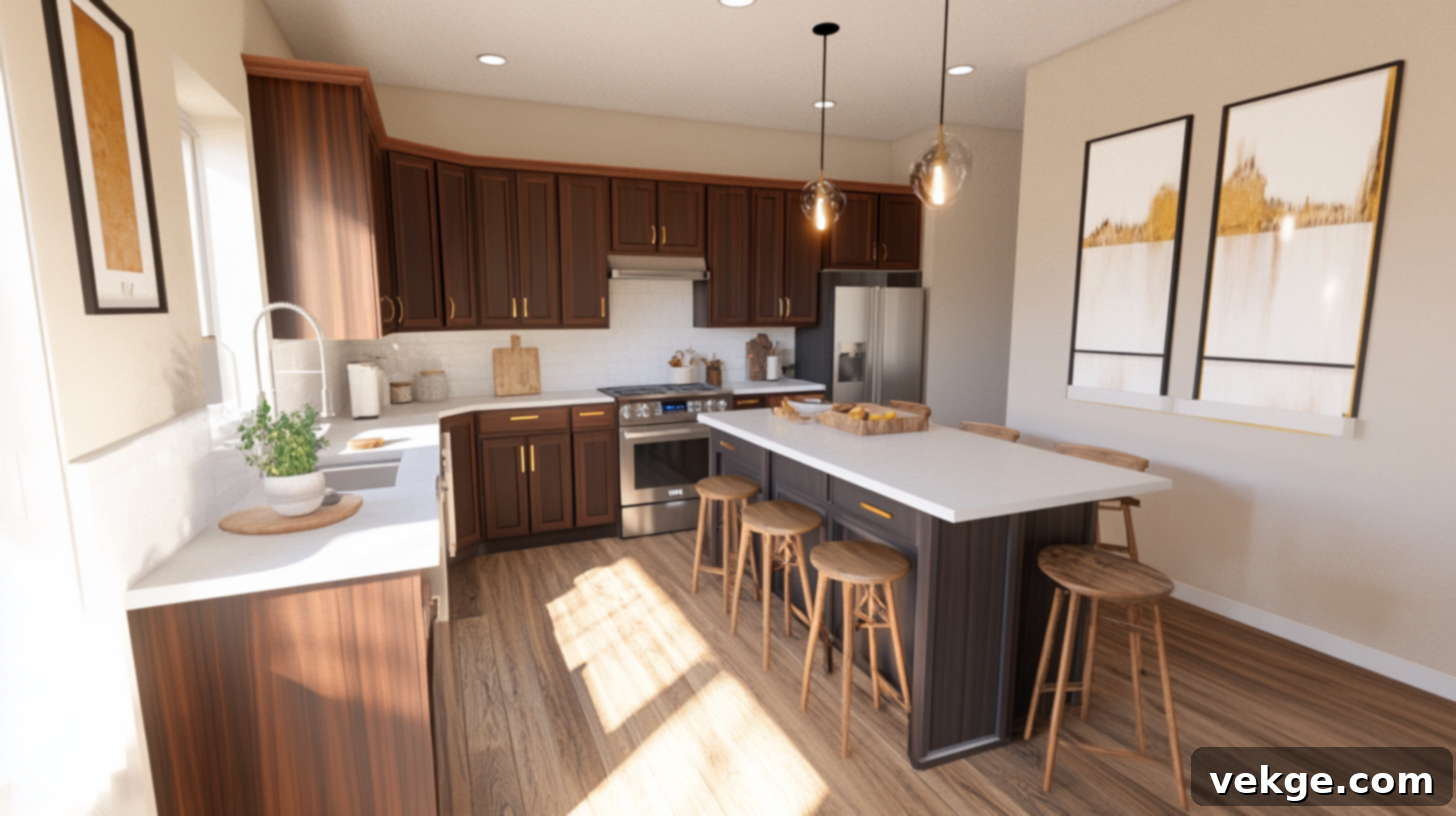Brown Cabinets with White Countertops: Your Ultimate Guide to a Stunning Kitchen Design
Are you envisioning a kitchen that radiates warmth, sophistication, and timeless appeal? Look no further than the exquisite combination of brown cabinets and white countertops. This classic pairing has captivated homeowners and designers for decades, offering a harmonious blend of natural charm and crisp, clean aesthetics. The rich, earthy tones of brown wood cabinets create an inviting and cozy atmosphere, while the bright, pristine white countertops introduce a sense of spaciousness and modernity.
This enduring mix is celebrated for its incredible versatility, seamlessly adapting to various kitchen sizes and architectural styles, from quaint country cottages to sleek urban lofts. Its lasting popularity means your kitchen will remain stylish and relevant for years to come. In this in-depth guide, we will explore everything you need to know about perfecting this design. We’ll delve into selecting the ideal color palettes to complement your brown cabinets and white countertops, discuss the best materials for durability and aesthetics, share expert styling tips to elevate your space, and help you sidestep common design pitfalls.
By the end of this article, you’ll be equipped with the knowledge and inspiration to create a kitchen that not only looks breathtaking but also functions perfectly for your daily life and family needs.
Why the Perfect Pair? Brown Cabinets and White Countertops
The synergy between brown cabinets and white countertops in kitchen design is truly remarkable. This dynamic duo offers a compelling array of benefits that make it a top choice for discerning homeowners. The inherent warmth of brown wood, whether light and airy or deep and luxurious, instantly grounds the space, creating a welcoming and comfortable environment. In contrast, the pristine white countertops act as a brilliant counterpoint, reflecting light and making the kitchen feel more expansive, brighter, and impeccably clean.
One of the most significant advantages of this combination is its remarkable adaptability. It effortlessly transcends various design aesthetics, from the rustic charm of a farmhouse kitchen to the sleek lines of a contemporary space, or the enduring elegance of a traditional setting. This timeless appeal ensures that your investment in a brown and white kitchen will stand the test of time, resisting fleeting trends and maintaining its sophisticated allure for decades.
The distinct contrast between the dark and light elements provides a visually pleasing balance, adding depth and structure to your kitchen’s overall look. Furthermore, brown cabinets and white countertops offer a neutral yet sophisticated foundation, making it incredibly easy to pair with diverse wall colors, flooring types, and decorative accents. This flexibility grants you immense creative freedom to personalize your kitchen, allowing it to evolve with your tastes and preferences over the years.
Harmonizing Your Kitchen: Pairing Colors with Brown Cabinets
Beyond the core cabinet and countertop choices, the surrounding color scheme plays a pivotal role in defining your kitchen’s atmosphere. Selecting the right wall colors can significantly enhance the appeal of your brown cabinets and white countertops, bringing out their best qualities and tying the entire room together. Here are some highly effective color matches that will help your kitchen achieve its full aesthetic potential:
- Beige: A perennial favorite, beige offers a gentle, cohesive backdrop that enhances the natural warmth of brown wood. It creates a soft, inviting ambiance, making your kitchen feel genuinely comforting and unified without being overpowering.
- Cream: Similar to beige but often with a slightly richer, more buttery undertone, cream adds subtle depth and a touch of classic elegance. It helps to soften the contrast between brown and white, contributing to a more seamless and open feel, particularly beneficial in smaller kitchens.
- Light Gray: For those seeking a more contemporary edge, light gray provides a sophisticated and modern touch. It expertly balances the inherent warmth of the brown cabinets, introducing a cool, refined contrast that prevents the space from feeling too traditional or rustic.
- Soft Blue: Introducing a fresh and calming pop of color, soft blues (like sky blue or dusty blue) stand out beautifully against the neutral brown and white foundation. They can evoke a coastal vibe or a serene, spa-like atmosphere, adding an unexpected layer of character.
- Sage Green: To foster a connection with nature, sage green offers an earthy and harmonious feel. It complements the wood tones of brown cabinets perfectly, creating a balanced and organic space that feels both tranquil and refreshing.
- Pale Yellow: Infuse your kitchen with bright, sunny energy by incorporating pale yellow. This cheerful hue works wonderfully with brown’s natural warmth, brightening the room and creating an uplifting, vibrant environment that feels welcoming and joyful.
Light vs. Dark Brown Cabinets: What Works Best for Your Space?
The specific shade of brown you select for your cabinets significantly influences the overall mood and perception of space in your kitchen. This crucial decision should align with your kitchen’s size, natural light availability, and your personal style preferences.
Light brown cabinets, such as those in maple, natural oak, or lighter cherry, are excellent for making rooms feel larger and more open. Their reflective quality is particularly advantageous in smaller kitchens or spaces that receive limited natural light, helping to brighten the area and create an airy, expansive feel. They offer a casual, approachable aesthetic and can easily lean towards modern farmhouse or Scandinavian styles.
Conversely, dark brown cabinets, like espresso, dark walnut, or deep mahogany, exude a rich, luxurious, and more formal look. They create a striking contrast against white countertops, making a bold statement and adding significant depth to the design. Darker cabinets often evoke a sense of grandeur and sophistication, perfect for traditional or opulent contemporary settings. On a practical note, darker finishes tend to conceal minor scuffs and marks more effectively than lighter ones. Your choice should ideally harmonize with your cleaning habits, the dimensions of your kitchen, and the ambient light conditions to achieve a balanced and appealing result.
Top Material Choices for Brown Cabinets and White Countertops
The materials you choose for your countertops are just as vital as the colors, impacting not only the aesthetic but also the functionality, durability, and maintenance of your kitchen. When paired with brown cabinets, certain white countertop materials truly shine. Here are some of the most popular and effective choices:
- Quartz: An engineered stone, quartz is renowned for its exceptional durability, non-porous surface, and minimal maintenance requirements. It offers a consistently clean and modern look and is available in a vast array of white shades, from brilliant pure white to subtle off-whites, ensuring a perfect match for any brown cabinet tone. It’s highly resistant to stains and scratches.
- Granite: As a natural stone, granite brings unique patterns and natural variations to each slab, adding undeniable character and interest to your kitchen. It is incredibly robust, highly resistant to heat, and comes in numerous white and off-white options, often with flecks or veins that can complement brown tones beautifully. However, it requires periodic sealing.
- Marble: For an unparalleled sense of luxury and classic elegance, marble is an iconic choice. Its distinctive natural veining makes each piece one-of-a-kind, elevating the entire space. While stunning, marble is softer and more porous than granite or quartz, requiring more diligent care to prevent etching and staining.
- Solid Surface: A man-made material (e.g., Corian), solid surface offers a smooth, seamless finish that can be thermoformed into unique shapes. It’s repairable if scratched or damaged and comes in consistent, uniform white shades, providing a clean and contemporary appearance. It’s also non-porous and hygienic.
- Concrete: A more industrial and modern option, concrete countertops can be custom-poured in pure white or various subtle off-whites. They are exceptionally strong and durable, offering a unique textural element. However, concrete requires regular sealing to protect against stains and needs professional installation.
Quartz Countertops: Unpacking the Pros and Cons for Brown Cabinets
Among the various options, quartz often emerges as a front-runner for white countertops in kitchens featuring brown cabinets due to its balanced blend of beauty and practicality. Its engineered composition means it doesn’t require the annual sealing typical of natural stones like granite or marble, making it an incredibly low-maintenance choice.
Pros: The non-porous nature of quartz makes it highly resistant to stains from common kitchen spills like coffee, wine, and oils, as well as scratches from everyday use. Its consistent coloration and patterns ensure that the white shade you choose will be uniform across all slabs, providing a cohesive look. With an extensive palette of whites, from bright, stark whites to softer, creamy, or even subtly veined options, quartz offers immense design flexibility to perfectly complement any shade of brown cabinet.
Cons: Despite its numerous advantages, quartz can sometimes be more expensive upfront than some natural stone or laminate options. Additionally, while highly heat-resistant, it’s not entirely impervious to extreme temperatures. Placing very hot pots or pans directly onto the surface without a trivet can potentially cause discoloration or damage, so care must be taken.
Elevate Your Space: How to Style Brown Cabinets and White Countertops
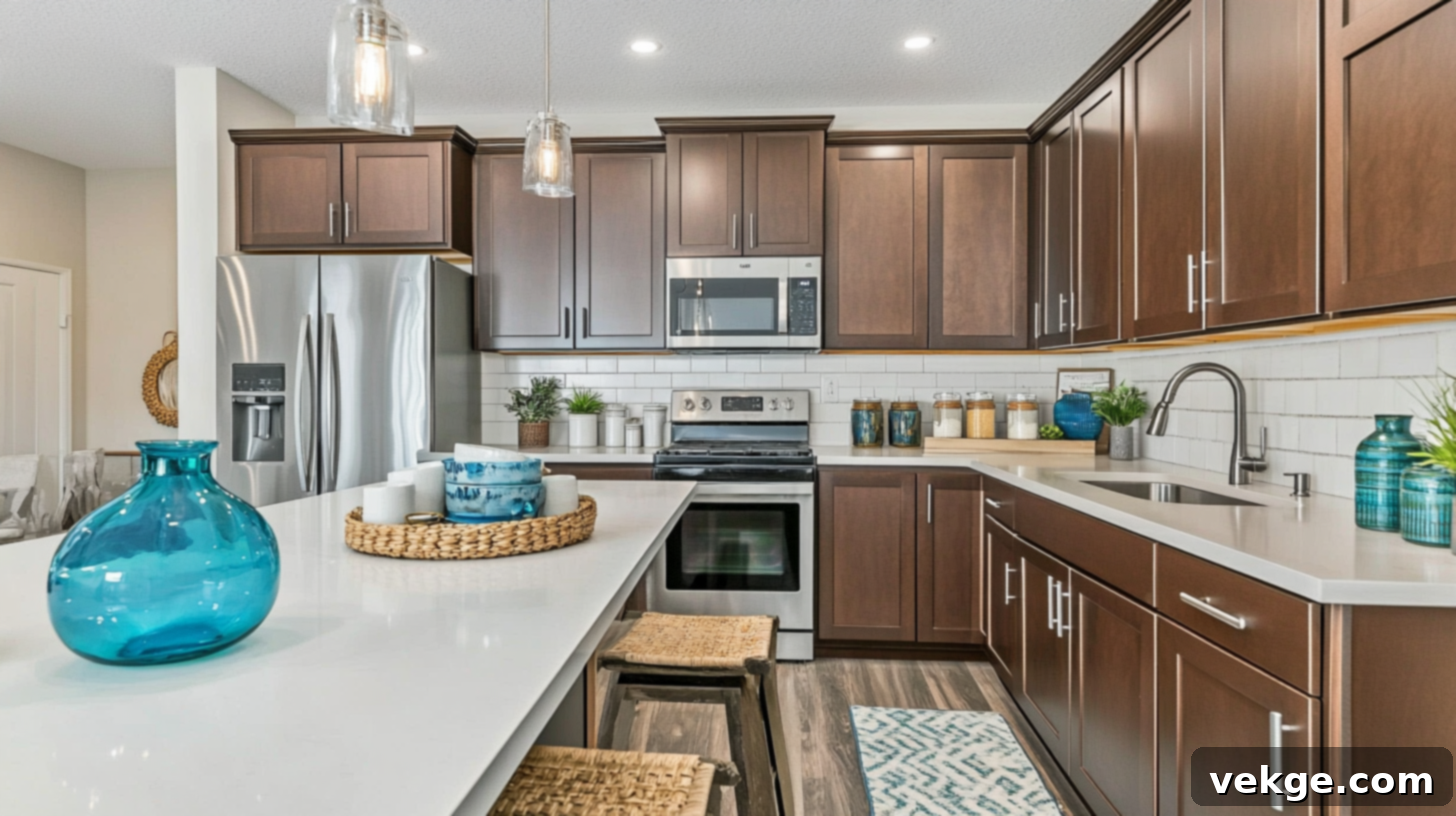
Once you’ve settled on the core elements of your brown cabinets and white countertops, the real magic happens in the styling. The right finishing touches can transform your kitchen from functional to truly spectacular, tying all elements together into a cohesive and inviting space. Let’s explore the key design elements that will help you achieve a polished and complete look.
1. Choosing the Right Hardware for Your Cabinets
Cabinet hardware—knobs, pulls, and handles—may seem like minor details, but they wield significant power in defining your kitchen’s style. They act as jewelry for your cabinets and can either blend seamlessly or create a striking contrast.
- Silver or Brushed Nickel: These finishes provide a clean, contemporary, and often minimalist look that beautifully complements both light and dark brown wood cabinets. They offer a cool contrast to the warmth of brown, enhancing a modern aesthetic.
- Matte Black: For a bold and dramatic statement, matte black hardware creates a powerful contrast, particularly effective against darker brown cabinets. It can lend an industrial, modern farmhouse, or sophisticated contemporary vibe.
- Brass or Gold Tones: If you’re aiming for warmth, luxury, or a touch of vintage charm, brass or gold-toned hardware adds a subtle gleam and richness. These metallic finishes beautifully enhance the inherent warmth and rich tones of brown wood, creating an inviting and opulent feel.
For a truly cohesive design, consider matching your kitchen faucet and light fixtures to your chosen hardware finish.
2. Best Backsplash Options to Tie it All Together
The backsplash serves as a crucial bridge between your brown cabinets and white countertops, offering an opportunity to introduce texture, pattern, or a pop of color while protecting your walls. The right backsplash can unify your kitchen’s design beautifully.
- Classic White Subway Tiles: This timeless choice maintains a clean, crisp aesthetic, allowing your stunning brown cabinets to remain the focal point. It’s versatile, budget-friendly, and always in style.
- Light Gray or Beige Tiles: These neutral tones offer a softer transition and can be more forgiving with splashes and everyday dirt than pure white, providing a practical yet elegant solution.
- Glass Tiles: In white, light blue, or even a subtle green, glass tiles add a reflective quality that enhances light and makes the space feel more open and modern. They can introduce a touch of subtle shimmer.
- Patterned Tiles: For those who desire a bolder statement, consider tiles with a subtle pattern that incorporates whites, creams, and perhaps a complementary brown or earthy tone. This can add visual interest without overwhelming the space.
3. Flooring Choices to Complement the Look
The flooring choice is fundamental, literally grounding your kitchen design and impacting both aesthetics and functionality. It should complement the brown and white scheme without competing with it.
- Wood Floors: Opt for wood flooring in a shade that is distinct from your cabinets—either lighter or darker—to create a layered, rich, and warm look. Light wood floors (like natural oak or birch) can make the room feel more expansive, while darker wood floors (like walnut or espresso) add a sense of luxury and depth.
- Tile: Large format tiles in shades of gray, beige, or even a subtle off-white are highly durable and practical. Larger tiles with fewer grout lines can visually enlarge a small space and offer a clean, streamlined appearance. Consider porcelain or ceramic for their resilience and ease of maintenance.
Always prioritize flooring that can withstand the demands of a kitchen, including spills, heavy foot traffic, and potential impacts.
4. Thoughtful Lighting Ideas for a Balanced Aesthetic
Proper lighting is essential not only for functionality but also for showcasing the beauty of your brown cabinets and white countertops. A well-designed lighting scheme enhances the ambiance and makes your kitchen a more enjoyable place to be.
- Under-Cabinet Lighting: Bright white LED strip lights installed under your upper cabinets illuminate your countertops, making task work easier and beautifully highlighting your backsplash.
- Pendant Lights: Above kitchen islands or peninsula, pendant lights provide both focused task lighting and a significant decorative element. Choose fixtures with metallic finishes that coordinate with your hardware for a unified look.
- Recessed Lighting: General overhead recessed lighting provides ambient light, ensuring the entire space is well-lit without creating shadows.
Opt for soft, warm-toned bulbs (around 2700K-3000K) for ambient and accent lighting to bring out the best in the brown wood tones, while task lighting can be brighter (3500K-4000K) for better visibility.
5. Adding Color Accents and Textures for Personality
While brown and white provide a sophisticated foundation, strategically placed color accents and varying textures can inject personality and warmth, preventing the space from feeling sterile or monotonous.
- Color Pops: Introduce vibrant hues through small, interchangeable items. Think bright blue or emerald green glass jars, decorative bowls, fresh fruit in a colorful bowl, or lively vases. These stand out beautifully against the neutral backdrop.
- Natural Elements: Incorporate living plants or herbs to add natural color, freshness, and life to the space. Their organic forms and green hues complement brown wood wonderfully.
- Textural Interest: Varying textures add visual depth. Consider woven baskets for storage, rough pottery pieces, a textured runner rug, or linen dishtowels. These elements create tactile appeal and make the kitchen feel more lived-in and inviting.
The key is to keep larger, more permanent items neutral and introduce color and texture through accessories that can be easily updated with changing seasons or tastes.
Inspiring Brown Cabinets White Countertops Design Ideas
Ready to visualize your dream kitchen? Here are several distinct design concepts showcasing how brown cabinets with white countertops can be styled to fit various aesthetic preferences and home styles. Each idea leverages the winning combination of warm brown and bright white to create a unique and captivating atmosphere.
Classic Elegance with Dark Brown Cabinets
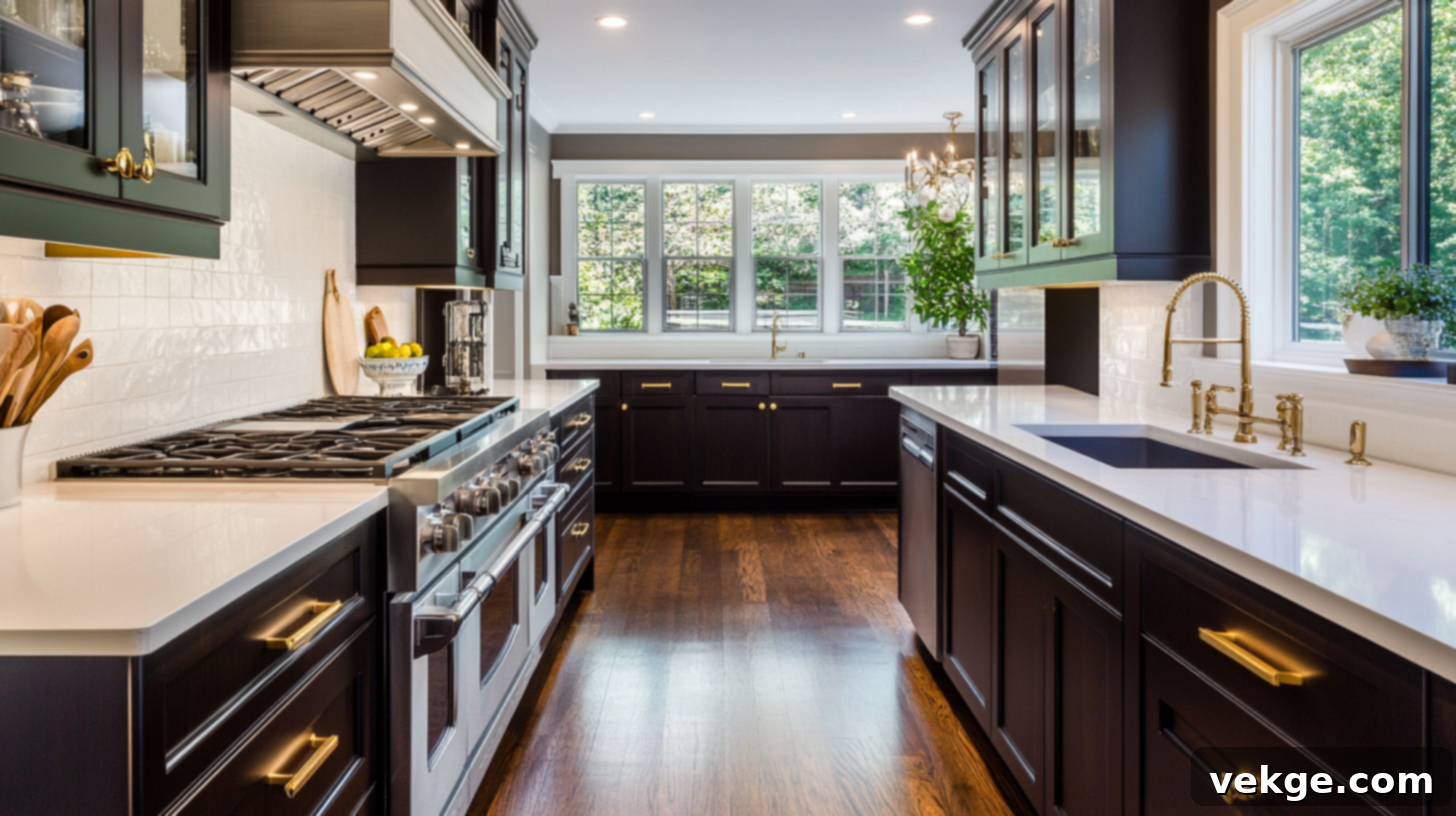
The pairing of dark brown cabinets with crisp white countertops is a testament to timeless sophistication. The deep, rich hue of the cabinets, such as espresso or dark walnut, imbues the room with a sense of warmth and understated luxury. Against this backdrop, the pure white countertops provide a striking contrast, creating a clean, expansive feel that prevents the space from appearing too heavy or enclosed.
To complete this elegant look, consider incorporating medium-toned wooden floors that subtly tie in with the cabinet color without matching exactly. Soft gold or antique brass handles and knobs can introduce a touch of opulence and reflect the cabinet’s warmth. This style is incredibly versatile, perfect for both traditional and more transitional kitchens. It conveys a sense of bespoke design, making every guest feel like they’ve stepped into a professionally curated space.
Modern Chic with Light Brown Cabinets

For those who crave a fresh, airy, and contemporary aesthetic, light brown cabinets, such as those made from natural maple or light oak, are an ideal choice. When combined with brilliant white countertops, this pairing creates a kitchen that feels open, clean, and remarkably inviting. This style truly shines in spaces abundant with natural light, where the lighter tones can reflect and amplify the brightness.
Embrace sleek, minimalist decor and stainless steel or black metal appliances to enhance the modern feel. Focus on clean lines, flat-panel doors, and understated details, avoiding any unnecessary fussiness. Unlike entirely white kitchens that can sometimes feel stark, this combination offers a serene yet warm atmosphere, perfect for homes that value clean, simple living and a fresh, uncluttered aesthetic.
Rustic Charm with Brown Cabinets

To evoke a sense of cozy, lived-in comfort, opt for brown cabinets with a distressed or reclaimed wood finish, paired with white stone countertops. The textured, worn look of the cabinets instantly adds character and history, creating a warm, inviting, and authentic rustic vibe. The white countertops are essential here, preventing the space from feeling too dark or overly antique, and providing a fresh, clean contrast that brightens the overall ambiance.
Consider replacing some upper cabinets with open shelving to display charming pottery, cookbooks, or vintage finds, making the space feel more accessible and homely. Industrial-style metal pendant lights or wrought-iron accents can further enhance the country house feel. This design strikes a perfect balance between comfort and cleanliness, ideal for homeowners who desire a kitchen that feels less like a showroom and more like the heart of a beloved family home.
Bold Contrast with High-Gloss Brown Cabinets
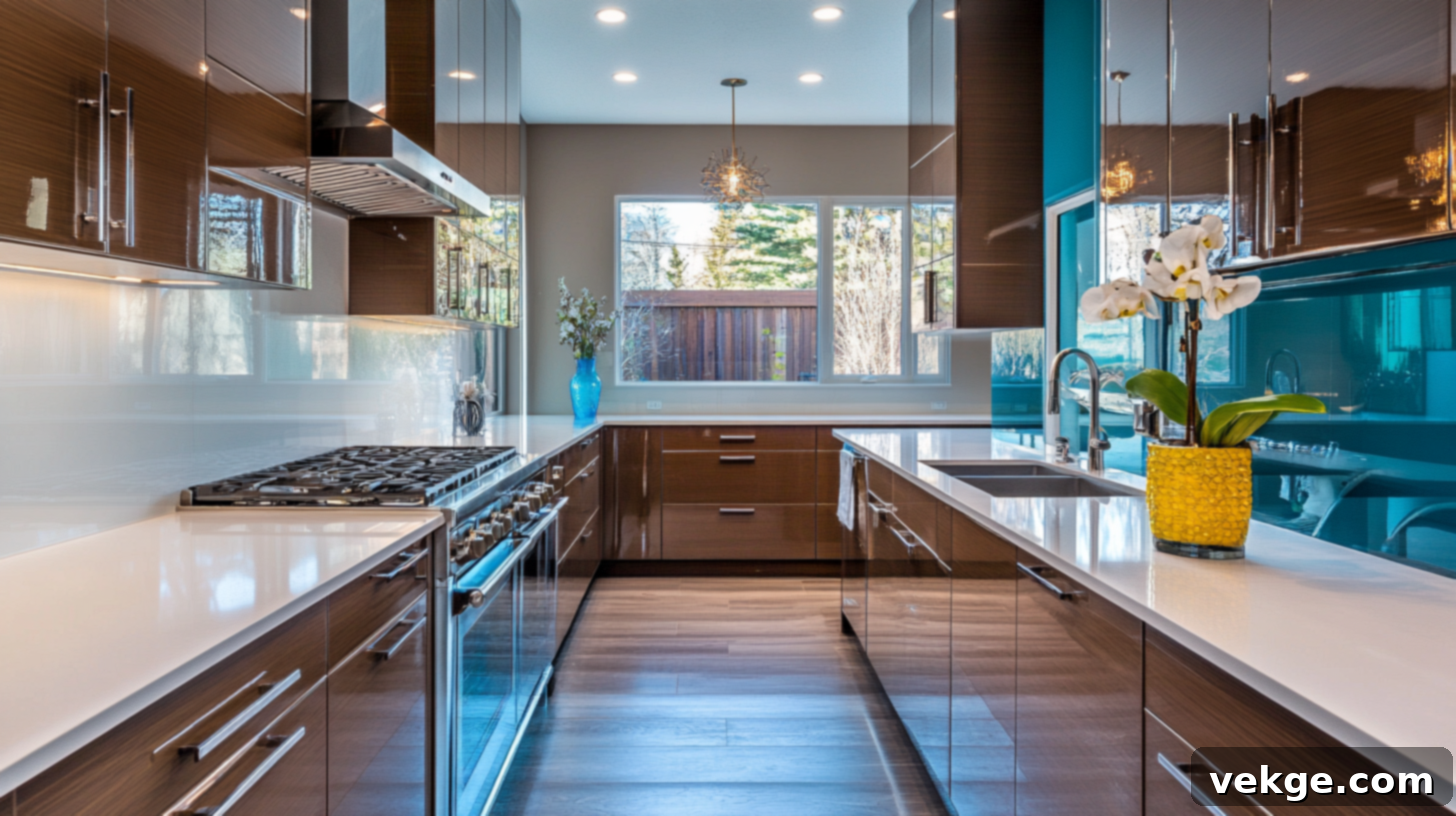
For a kitchen that makes a truly impactful first impression, high-gloss brown cabinets are an exceptional choice. Their reflective, lustrous surface immediately catches the eye, creating a sense of contemporary flair and drama. When juxtaposed with pure white countertops, this combination delivers a powerful, high-contrast look that exudes sophistication and modern luxury. To intensify the visual excitement, consider a bold backsplash in a deep jewel tone like emerald green or sapphire blue.
This design is anything but shy – it’s designed to impress! The glossy finish not only looks sleek but also helps light bounce around the room, making the space feel more dynamic and expansive. To maintain this bold aesthetic, prioritize clean lines, handle-less cabinets, and minimalist shapes in your overall design. This style is perfectly suited for those who want their kitchen to be a striking focal point, reflecting a confident and contemporary taste.
Warm and Inviting with Medium Brown Cabinets
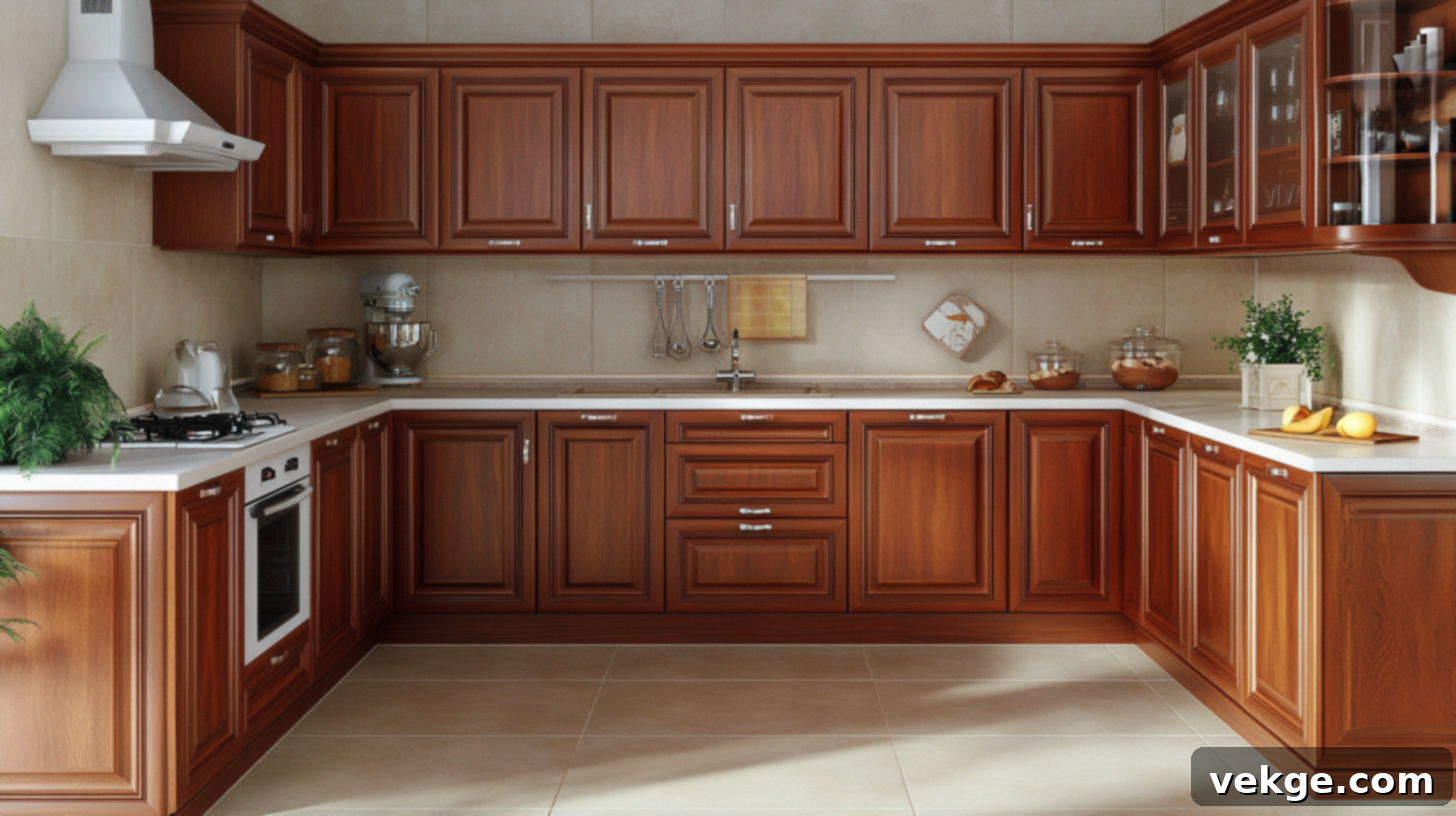
Medium brown cabinets, such as those made from natural cherry, alder, or a mid-tone stained oak, strike a perfect balance – they are neither too dark nor too light. When paired with white countertops, they create a wonderfully balanced, friendly, and inherently welcoming kitchen environment. This “sweet spot” in brown tones makes the space feel instantly comfortable and approachable. Soft tan or light gray walls beautifully complement this setup, adding to the cozy ambiance without darkening the room.
This combination embodies a feeling of “home” from the moment you step in. Its versatility allows it to blend seamlessly with most home styles, ensuring it remains appealing and current for many years. Enhance the welcoming atmosphere with natural elements like potted plants, warm-toned lighting fixtures, and comfortable seating. This design invites family and friends to gather, creating a cherished hub where memories are made every day.
Common Mistakes to Avoid While Styling Your Kitchen
Achieving the perfect look with brown cabinets and white countertops requires thoughtful planning and an awareness of potential pitfalls. Steering clear of these common design errors will save you significant time, money, and the frustration of a kitchen that doesn’t quite meet your vision. Let’s delve into the mistakes you should avoid to ensure a harmonious and stunning result:
- Using too many competing wood tones: While layering different textures is good, introducing too many disparate shades of brown wood (e.g., cabinets, flooring, island base, dining table) can make the kitchen feel cluttered and visually chaotic. Stick to one dominant wood tone for your cabinets and choose complementary, rather than clashing, shades for other wooden elements. Aim for subtle variations in warmth and grain, not stark differences in color.
- Picking pure, stark bright white for everything: While white countertops are key, using pure, brilliant white for all other white elements (walls, backsplash, decor) can create an overly harsh contrast, making the kitchen feel cold, sterile, or even clinical. Instead, opt for softer white shades with warm undertones (like off-white, cream, or antique white) for your backsplash, paint, or accessories. This creates a more nuanced, inviting, and balanced look that harmonizes beautifully with the warmth of brown wood.
- Overlooking adequate lighting needs: A kitchen with brown cabinets, especially darker ones, can easily appear dark and gloomy if not properly lit. Relying solely on a single overhead light source is a common mistake. Layer different types of lighting—ambient (general), task (focused on work areas), and accent (to highlight features)—to illuminate every corner. Bright under-cabinet lights, stylish pendants, and well-placed recessed lighting are essential for both functionality and showcasing your kitchen’s best features.
- Choosing the wrong or too many metal finishes: Mixing too many different metal finishes (e.g., brushed nickel, polished chrome, matte black, oil-rubbed bronze) for hardware, faucets, and light fixtures can create a disjointed and messy appearance. Select one or two complementary main finishes and stick with them throughout the kitchen. For instance, if you choose brushed nickel hardware, ensure your faucet and light fixtures also align with this tone or a closely related one.
- Going overboard with patterns: While patterns add interest, overdoing them on elements like the backsplash, flooring, patterned wallpaper, and accessories can make the space feel overwhelming and chaotic. The brown cabinets and white countertops already offer a strong visual dynamic. Choose one statement piece for pattern (e.g., a patterned tile backsplash or a unique floor design) and keep other elements simpler and more subdued. This allows the chosen pattern to shine without competing with other visual information.
Wrapping Up: Your Dream Kitchen Awaits!
The marriage of brown cabinets and white countertops is a classic design choice that promises to transform the heart of your home. This powerful combination effortlessly brings together warmth, natural beauty, and bright, clean sophistication into one cohesive space. You now possess a wealth of knowledge, from understanding which colors will beautifully complement this pairing and selecting the most durable and aesthetically pleasing materials, to applying expert styling tips for everything from flooring to lighting.
You’re now perfectly positioned to embark on your kitchen design journey with confidence. Remember to integrate some of our practical suggestions, such as introducing small pops of color with vibrant plants or decorative jars, or carefully selecting hardware that perfectly aligns with your personal style and desired aesthetic. Even seemingly minor adjustments can yield a significant impact on the overall look and feel of your kitchen.
Take your time to meticulously plan each detail, visualize how elements will interact, and allow your creativity to flow. Soon, you will not only have a kitchen that is stunningly beautiful and deeply inviting but also one that is perfectly tailored to meet the unique needs and lifestyle of your family. Your ideal kitchen, featuring the timeless elegance of brown cabinets and white countertops, is just waiting for you to bring it to life!
